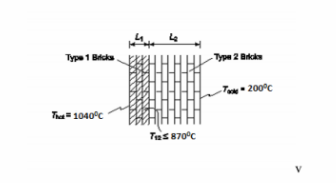A 3.0-kg bowling ball experiences a net force of 8.0 N. What will be its acceleration?
a. 24 m/s2
b. 3.0 m/s2
c. 8.0 m/s2
d. 2.7 m/s2
e. 0.38 m/s2
d
You might also like to view...
Estimate the thermal conductivity of platinum at -10ºC if its electrical conductivity is 6 x 10^7 mhos/m, based on the Wiedemann-Franz law. Note: 1 mho = 1 amp/volt = 1 coulomb/volt-s, 1 W = 1 J/s = 1 volt-coulomb/s.
What will be an ideal response?
What happens to the image in a pinhole camera if the screen is moved closer to the pinhole?
A. The image decreases in size. B. The image increases in size. C. The image remains the same size. D. The image is blurry
A furnace wall is to be constructed of brick having standard dimensions 22.5 cm* 11 cm * 7.5 cm. Two kinds of material are available. One has a maximum usable temperature of 1040°C and a thermal conductivity of 1.7 W/(m K), and the other has a maximum temperature limit of 8700C and a thermal conductivity of 0.85 W/(m K). The bricks have the same cost and are laid in any manner, but we wish to design the most economical wall for a furnace with a temperature of 10400C the hot side and 2000C on the cold side. If the maximum amount of heat transfer permissible is 950 W/m2 , determine the most economical arrangement using the available bricks.
GIVEN
Furnace wall made of 22.5 ? 11 ? 7.5 cm bricks of two types
Type 1 bricks Maximum useful temperature (T1,max) = 1040°C=1313 K
Thermal conductivity (k1) = 1.7 W/(m K)
Type 2 bricks Maximum useful temperature (T2,max) = 870°C= 1143 K
Thermal conductivity (k2) = 0.85 W/(m K)
Bricks cost the same
Wall hot side (Thot) = 1040°C=1313 K and cold side (Tcold) = 200°C=473 K
Maximum heat transfer permissible (qmax/A) = 950 W/m2
FIND
The most economical arrangement for the bricks
ASSUMPTIONS
One dimensional, steady state heat transfer conditions
Constant thermal conductivities
The contact resistance between the bricks is negligible
SKETCH

Which piece of glass will warm up quicker in sunlight?
A) colored glass B) clear glass C) both the same